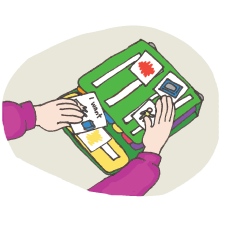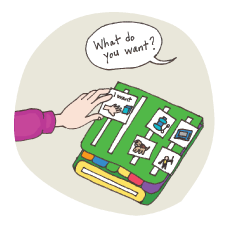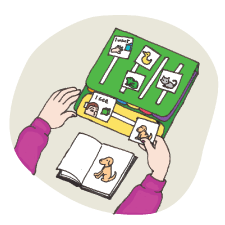What is PECS®?
Developed by Andy Bondy, PhD & Lori Frost, MS, CCC-SLP
PECS is a unique alternative/augmentative communication system developed in the USA in 1985 by Andy Bondy, PhD, and Lori Frost, MS, CCC-SLP. PECS was first implemented with pre-school students diagnosed with autism at the Delaware Autism Program. Since then, PECS has successfully been implemented worldwide with thousands of learners of all ages who have various cognitive, physical and communication challenges.
The PECS teaching protocol is based on B.F. Skinner’s book, Verbal Behavior, and broad spectrum applied behaviour analysis. Specific prompting and reinforcement strategies that will lead to independent communication are used throughout the protocol. The protocol also includes systematic error correction procedures to promote learning if an error occurs. Verbal prompts are not used, thus building immediate initiation and avoiding prompt dependency.
PECS consists of six phases and begins by teaching an individual to give a single picture of a desired item or action to a “communicative partner” who immediately honors the exchange as a request. The system goes on to teach discrimination of pictures and how to put them together in sentences. In the more advanced phases, individuals are taught to use modifiers, answer questions and comment.
The primary goal of PECS is to teach functional communication. Research has shown that some learners using PECS also develop speech. Others may transition to a speech generating device (SGD). The body of research supporting the effectiveness of PECS as an evidence-based practice is substantial and continues to expand, with more than 190 research articles from all over the world.
The Six Phases of PECS®

PHASE I
Individuals learn to exchange single pictures for items or activities they really want.

PHASE II
Still using single pictures, individuals learn to generalise this new skill by using it in different places, with different people and across distances. They are also taught to be more persistent communicators.

PHASE III
Individuals learn to select from two or more pictures to ask for their favorite things. These are placed in a PECS Communication Book—a ringed binder with self-adhesive hook fastener strips where pictures are stored and easily removed for communication.

PHASE IV
Individuals learn to construct simple sentences on a detachable Sentence Strip using an “I want” picture followed by a picture of the item being requested.

Attributes & Language Expansion

PHASE V
Individuals learn to use PECS to answer questions such as “What do you want?”

PHASE VI
Individuals are taught to comment in response to questions such as, “What do you see?”, “What do you hear?” and “What is it?” They learn to make up sentences starting with “I see”, “I hear”, “I feel”, “It is a”, etc.
Since its development, PECS has been implemented with individuals with the following diagnoses:
- 15q Deletion Syndrome
- 16p11.2 Deletion Syndrome
- 18q Deletion Syndrome
- Agenesis of the Corpus Collosum
- Aicardi Syndrome
- Alzheimer’s Disease
- Angelman Syndrome
- Apert Syndrome
- Aphasia
- apraxia/dyspraxia
- Asperger Syndrome
- autism
- brain anomaly
- brain tumor
- cerebral palsy (CP)
- CHARGE Syndrome
- cleft lip and/or palate
- cochlear implant
- Cornelia de Lange Syndrome (CdLS)
- Cri du Chat Syndrome
- Cytomegalovirus (CMV)
- Dandy-Walker Syndrome
- deaf/hearing impaired
- developmental delay
- DiGeorge Syndrome (velo cardio facial syndrome/22q11.2 deletion)
- Down syndrome
- Dubowitz Syndrome
- English as a 2nd language (ESL)
- Fetal Alcohol Syndrome
- Fragile X Syndrome
- Isodicentric 15/idic 15
- Kabuki Syndrome
- KCNT1 epilepsy
- microcephaly
- Neurofibromatosis
- Noonan Syndrome
- Noonan Syndrome
- Opitz Syndrome
- Partial Trisomy, 4P
- Phelan-McDermid (22q13 Deletion) Syndrome
- Rett Syndrome
- seizure disorder/epilepsy
- Selective Mutism
- Septo-optic dysplasia
- speech/language delay
- Tourette Syndrome
- traumatic/acquired brain injury
- Treacher-Collins Syndrome
- Tuberous Sclerosis Complex (TSC)
- Turner Syndrome
- unilateral polymicrogyria
- Van Lohuizen Syndrome
- Williams Syndrome
- Wolf Hirschorn Syndrome

